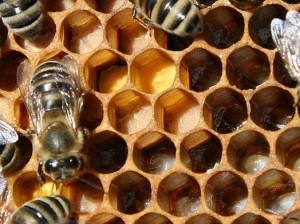THURSDAY, 20 MAY 2010
Scientists have frequently sought inspiration from the natural world when designing sophisticated materials, with the macroscopic hexagonal design of honeycomb often used in high performance cellular materials. Though the hexagonal geometry of honeycomb is familiar to many, the microscopic intricacies of the cell wall material are perhaps not. Honeycomb cell walls consist primarily of wax and silk, the latter being added as bee larvae pupate and leave behind their silk cocoons to be covered in wax by worker bees.This natural composite material was shown to be significantly less sensitive to rising temperatures than younger honeycomb with lower silk levels. Temperatures inside honeycombs can vary by up to 20 degrees celcius and the ability of the comb to retain its structural integrity within this range is paramount to the hive's existence. The researchers found that a fully laden, fresh honeycomb could collapse at warmer temperatures if silk was not included in the cell walls. Mechanical testing of the cell walls showed a threefold stiffness increase after a year's worth of silk (up to 33%) and wax was added.
In conventional cellular materials the overall stiffness and degree of thermal expansion cannot exceed that displayed by the cell wall material, regardless of the microstructure displayed. The researchers show how honeybees overcome this limitation, with older honeycombs retaining their stiffness at a range of temperatures, an observation attributed to the non-homogeneity of the cell walls achieved by inclusion of silk layers.
The researchers hope this study will lead the way for novel engineered cellular materials which possess mechanical properties not limited by a homogeneous cell wall. Cell walls consisting of artificial composites, mimicking honeycomb's silk and wax layers, may have potential applications to guard against the large temperature fluctuations experienced in space.

